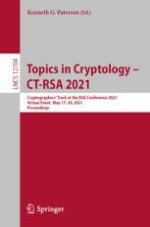2021 | Buch
Topics in Cryptology – CT-RSA 2021
Cryptographers’ Track at the RSA Conference 2021, Virtual Event, May 17–20, 2021, Proceedings
herausgegeben von: Kenneth G. Paterson
Verlag: Springer International Publishing
Buchreihe : Lecture Notes in Computer Science
